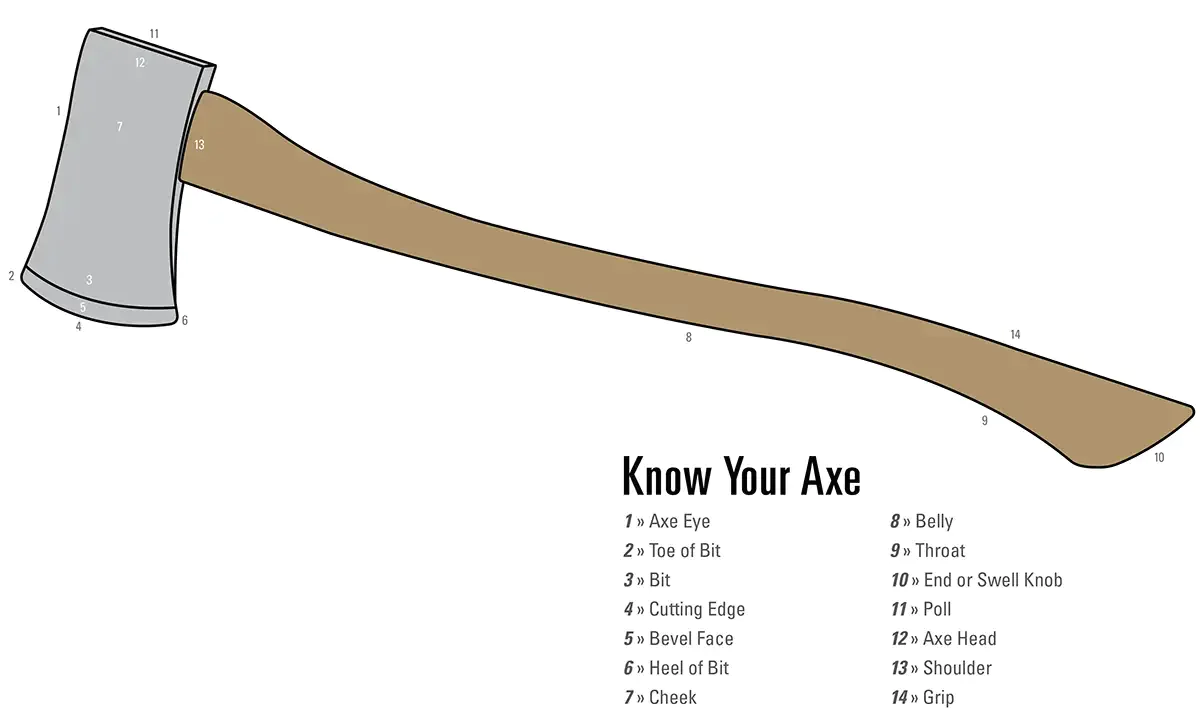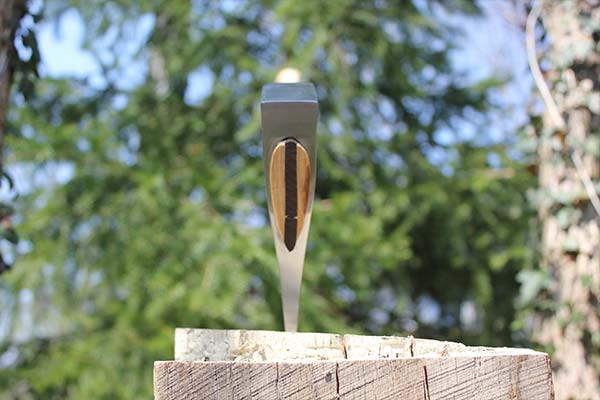The axe is an iconic and enduring symbol of human ingenuity, with its roots dating back thousands of years. This versatile tool has been indispensable to our ancestors, playing a pivotal role in shaping civilizations and taming the wilderness.
Let's delve into the intricate details of the axe's construction, exploring each component and its purpose. By understanding the anatomy of an axe, you'll gain a deeper appreciation for this deceptively complex tool.

HANDLE OR HAFT
As you can guess, the purpose of an axe handle is to provide a grip for the user — but there's more to it than that. A good handle can absorb shock and vibration while still being comfortable to grasp, making the job of chopping wood or felling trees less fatiguing.
Some handles include features like ergonomic shaping or non-slip coatings for added comfort and safety. Additionally, modern-day axe handles are made out of wood or fiberglass:
- Wooden handles require more care over time; they can dry out or break if not properly taken care of. However, a good quality wooden handle can provide comfort, personalization, and a timeless look.
- Fiberglass handles are lightweight and offer better durability compared to wooden ones. A drawback is that they do not absorb shock like a wooden handle (or look as nice).
The parts of the axe handle or haft are the end knob, throat, belly, back, and shoulder.
End Knob
At the bottom of the handle, you’ll find the end knob, which prevents the axe from slipping out of your grip. There are also variations of the end knob. Fawn's Foot, Swell End, Scroll-End anyone?
Throat & Belly
The throat and belly are found towards the bottom and rear parts of the handle.
Directly above the end knob is the throat. Gripping the throat will allow you to add a lot of power to your swing, but decrease accuracy. However, this is the optimal place to grip when there is a lot of material to remove and your dominant hand is out of the way.
The belly is located just above the throat, where the handle curves slightly in. Gripping the axe at the belly provides a good balance between power and control.
Shoulder & Back
In between the belly and the head of the axe is the shoulder. Gripping the shoulder allows the best control of the axe but provides little power. It’s best to grip the shoulder when doing high-precision work.
The back of the handle is where all the parts of the handle are joined. The back provides support and a better grip for the user.
HEAD
The head is attached to its handle through its eyehole at one end and extends out into its bit and cutting edge at another end — this shape allows for maximum force when striking material to split or chop it effectively.
Depending on the type of axe you’re using, you’ll notice different head shapes and sizes. For instance, a hatchet has a smaller head compared to a felling axe. The smaller head makes the hatchet better for more manageable tasks like cutting kindling, while the bigger felling axe is more suited for chopping down trees.
The axe head is made up of the poll or butt, cheek, eye, bit, cutting edge, bevel, toe, heel, and beard.
Poll or Butt
The poll is located on the opposite side of the bit and can include various features such as hammering faces, nail pullers, spike heads, etc., depending on what type of axe you have. Brant & Cochran squares the poll, but you also find ones that are rounded.
Cheeks
The cheeks are the sides of the axe head; this part acts as a counterweight, helping you control your swing better.
Eye
The hole at the end of the axe head is called the eye. The haft goes right through the head to the eye. One of the telltale signs of a good axe is if the grain of the haft is parallel to the axe head, as this allows maximum durability.
Bit, Cutting Edge & Bevel
The bit of the axe does the majority of the work in chopping wood. It’s best to keep it sharp for optimal performance, using a honing puck or honing paddle. The bit of an axe can be further divided into sections: the bevel, cutting edge, toe, heel, and beard.
The shiny part of the axe head is called the bevel; it has a slight angle near the cutting edge to control splitting wood fibers. The cutting edge is located on both sides where the bevel meets to form a sharp edge. As you can guess, this is the part that is responsible for the actual cutting.
Toe & Heel
The toe is found at the top-most part of the bit and helps guide when swinging. The heel is the bottom-most part of the bit. In some cases, the heel is used for carving, detailing, or even puncturing.
Beard
The beard is the section of the bit that extends downwards towards the handle. A bearded axe gives your fingers additional space, allowing you to grip right behind the cutting edge. Having your hand right behind the cutting edge gives you even better accuracy.
An axe is an essential tool that’s used worldwide. While it may look like a simple tool, it has many distinct parts and a complex anatomy. We hope that this will help you choose the right axe for your next project!
